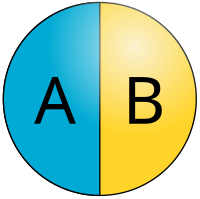
Janus particles are special types of nanoparticles or microparticles whose surfaces have two or more distinct physical properties.[1][2] This unique surface of Janus particles allows two different types of chemistry to occur on the same particle. The simplest case of a Janus particle is achieved by dividing the particle into two distinct parts, each of them either made of a different material, or bearing different functional groups.[3] For example, a Janus particle may have one half of its surface composed of hydrophilic groups and the other half hydrophobic groups,[4] the particles might have two surfaces of different color,[5] fluorescence, or magnetic properties.[6] This gives these particles unique properties related to their asymmetric structure and/or functionalization.[7]
- ^ Li, Fan; Josephson, David P.; Stein, Andreas (10 January 2011). "Colloidal Assembly: The Road from Particles to Colloidal Molecules and Crystals". Angewandte Chemie International Edition. 50 (2): 360–388. doi:10.1002/anie.201001451. PMID 21038335.
- ^ Janus Particle Synthesis, Self-Assembly and Applications, Editors: Shan Jiang, Steve Granick, Royal Society of Chemistry, Cambridge 2013, https://pubs.rsc.org/en/content/ebook/978-1-84973-510-0
- ^ Cite error: The named reference
Nano today review 2011was invoked but never defined (see the help page). - ^ Granick, Steve; Jiang, Shan; Chen, Qian (2009). "Janus particles". Physics Today. 62 (7): 68–69. Bibcode:2009PhT....62g..68G. doi:10.1063/1.3177238.
- ^ "Rotation and Orientation of Dual-Functionalized Electrophoretic Microspheres in Electromagnetic Field". www.cospheric.com. Retrieved 30 April 2019.
- ^ "Retroreflective Microspheres, Metal-Coated Glass Particles, Microbeads, Spherical Glass Powder - Principles and Operation". www.cospheric.com. Retrieved 30 April 2019.
- ^ Walther, Andreas; Müller, Axel (2013). "Janus Particles: Synthesis, Self-Assembly, Physical Properties, and Applications". Chemical Reviews. 113 (7): 5194–261. doi:10.1021/cr300089t. PMID 23557169.